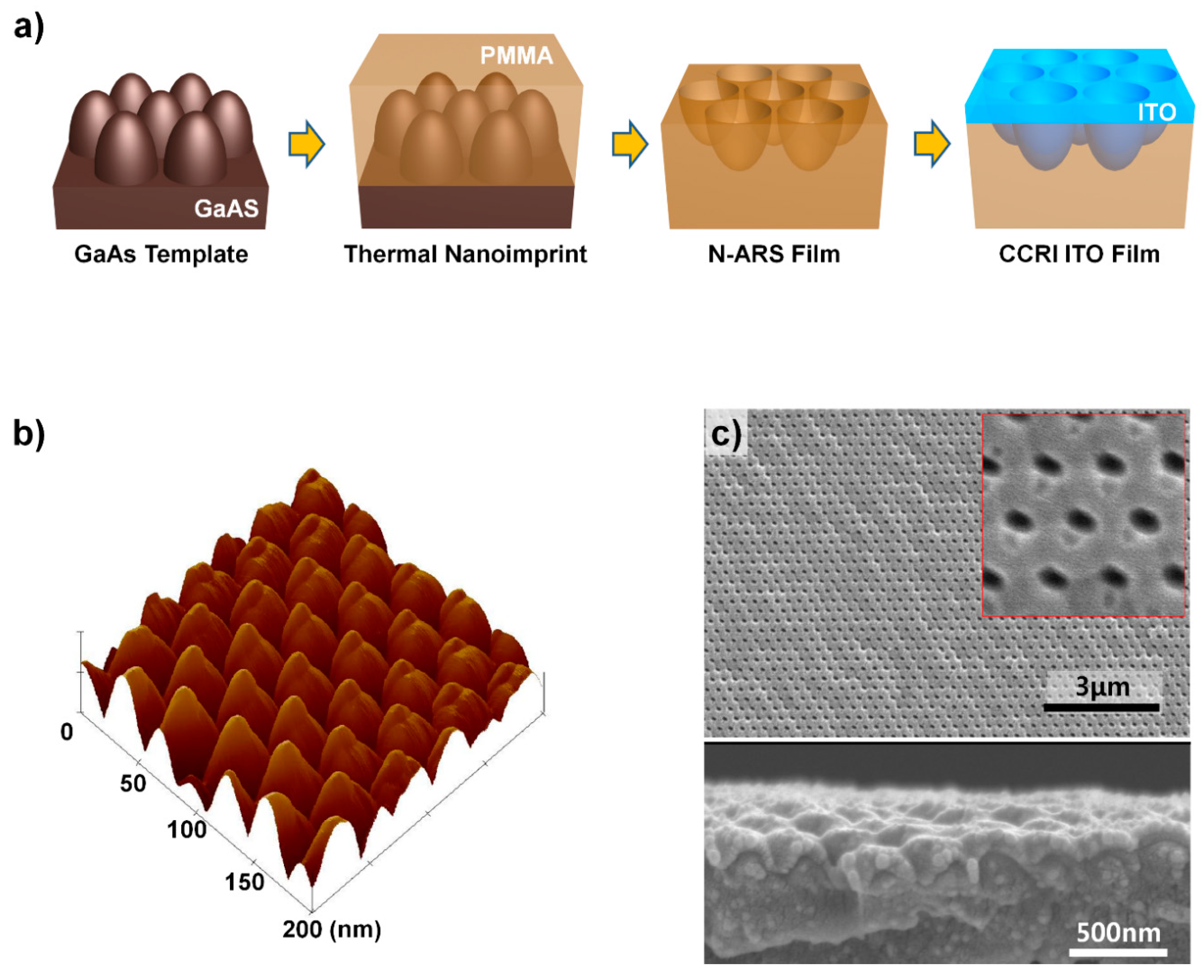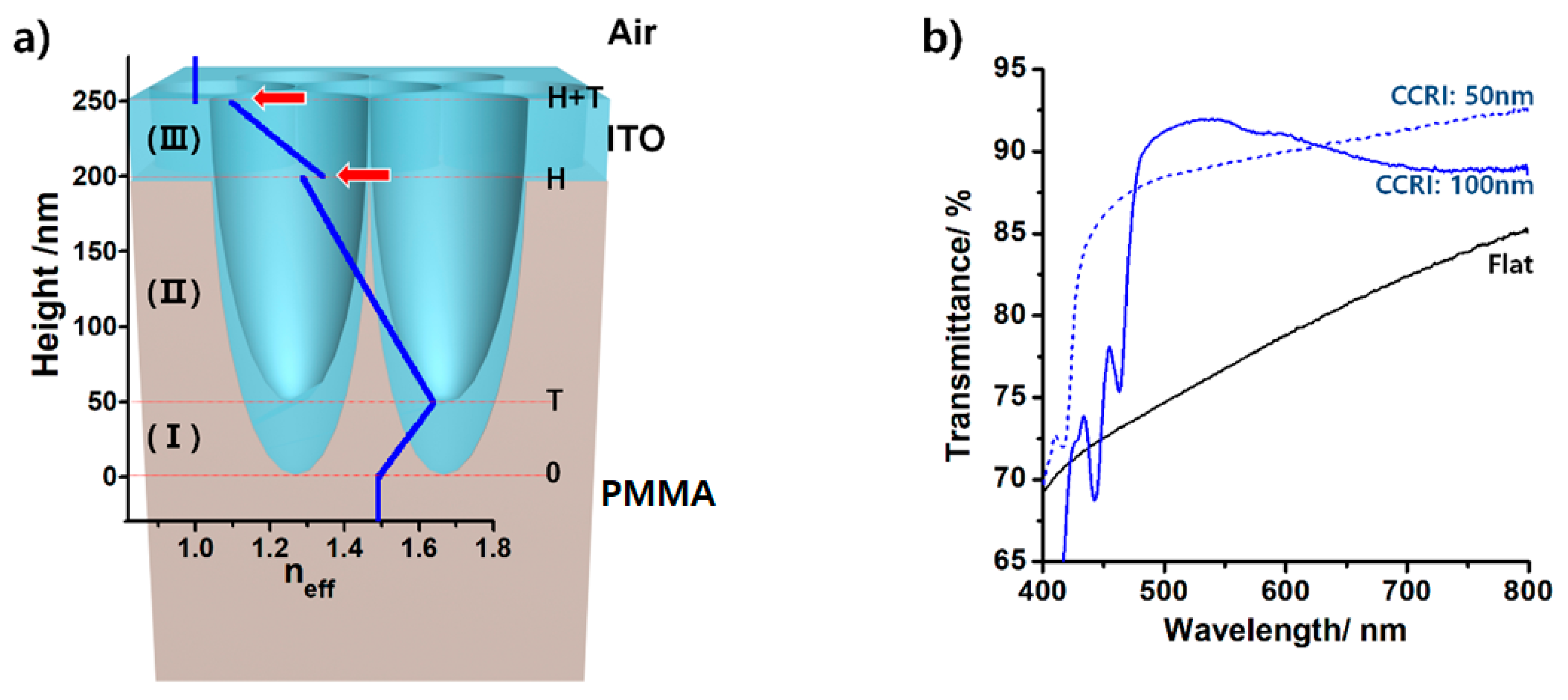Antireflective Transparent Conductive Oxide Film Based on a Tapered Porous Nanostructure
Abstract
1. Introduction
2. Materials and Methods
3. Results and Discussion
4. Conclusions
Author Contributions
Funding
Conflicts of Interest
References
- Reineke, S.; Lindner, F.; Schwartz, S.; Seidler, N.; Walzer, K.; Lussem, B.; Leo, K. White organic light-emitting diodes with fluorescent tube efficiency. Nature 2009, 459, 234–238. [Google Scholar] [CrossRef]
- Sakthivel, P.; Murugan, R.; Asaithambi, S.; Karuppaiah, M.; Vijayaprasath, G.; Rajendran, S.; Hayakawa, Y.; Ravi, G. Studies on optoelectronic properties of magnetron Sputtered cadmium stannate (Cd2SnO4) thin films as alternative TCO materials for solar cell applications. Ceram. Int. 2018, 44, 2529–2538. [Google Scholar] [CrossRef]
- Caruge, J.M.; Halpert, J.E.; Wood, V.; Bulovic, V.; Bawendi, M.G. Colloidal quantum-dot light-emitting diodes with metal-oxide charge transport layers. Nat. Photonics 2008, 2, 247–250. [Google Scholar] [CrossRef]
- Sun, Y.; Forrest, S.R. Enhanced light out-coupling of organic light-emitting devices using embedded low-index grids. Nat. Photonics 2008, 2, 483–487. [Google Scholar] [CrossRef]
- Wu, W.-Q.; Feng, H.-L.; Chen, H.-Y.; Kuang, D.-B.; Su, C.-Y. Recent advances in hierarchical three-dimensional titanium dioxide nanotree arrays for high-performance solar cells. J. Mater. Chem. A 2017, 5, 12699–12717. [Google Scholar] [CrossRef]
- Yip, H.-L.; Hau, S.K.; Baek, N.S.; Ma, H.; Jen, A.K.-Y. Polymer Solar Cells That Use Self-Assembled-Monolayer-Modified ZnO/Metals as Cathodes. Adv. Mater. 2008, 20, 2376–2382. [Google Scholar] [CrossRef]
- Wu, Z.; Yang, Z.; Xue, K.; Fei, C.; Wang, F.; Yan, M.; Zhang, H.; Ma, D.; Huang, W. Performance enhancement of single layer organic light-emitting diodes using chlorinated indium tin oxide as the anode. RSC Adv. 2018, 8, 11255–11261. [Google Scholar] [CrossRef]
- Ham, E.V.D.; Elen, K.; Bonneux, G.; Maino, G.; Notten, P.; Van Bael, M.; Hardy, A. 3D indium tin oxide electrodes by ultrasonic spray deposition for current collection applications. J. Power Sources 2017, 348, 130–137. [Google Scholar]
- Kim, H.; Gilmore, C.M.; Horwitz, J.S.; Piqué, A.; Murata, H.; Kushto, G.P.; Schlaf, R.; Kafafi, Z.H.; Chrisey, D.B. Transparent conducting aluminum-doped zinc oxide thin films for organic light-emitting devices. Appl. Phys. Lett. 2000, 76, 259–261. [Google Scholar] [CrossRef]
- Batzill, M.; Diebold, U. The surface and materials science of tin oxide. Prog. Surf. Sci. 2005, 79, 47–154. [Google Scholar] [CrossRef]
- Walheim, S. Nanophase-Separated Polymer Films as High-Performance Antireflection Coatings. Science 1999, 283, 520–522. [Google Scholar] [CrossRef] [PubMed]
- Poitras, D.; Dobrowolski, J.A. Toward perfect antireflection coatings. 2. Theory. Appl. Opt. 2004, 43, 1286–1295. [Google Scholar] [CrossRef]
- Chhajed, S.; Schubert, M.F.; Kim, J.K.; Schubert, E.F. Nanostructured multilayer graded-index antireflection coating for Si solar cells with broadband and omnidirectional characteristics. Appl. Phys. Lett. 2008, 93, 251108. [Google Scholar] [CrossRef]
- Choi, K.; Yoon, Y.; Jung, J.; Ahn, C.W.; Lee, G.J.; Song, Y.M.; Ko, M.J.; Lee, H.S.; Kim, B.; Kang, I.-S. Antireflective Films: Super-Antireflective Structure Films with Precisely Controlled Refractive Index Profile. Adv. Opt. Mater. 2017, 5, 1600616. [Google Scholar] [CrossRef]
- Kim, J.K.; Chhajed, S.; Schubert, M.F.; Schubert, E.F.; Fischer, A.J.; Crawford, M.H.; Cho, J.; Kim, H.; Sone, C. Light-Extraction Enhancement of GaInN Light-Emitting Diodes by Graded-Refractive-Index Indium Tin Oxide Anti-Reflection Contact. Adv. Mater. 2008, 20, 801–804. [Google Scholar] [CrossRef]
- Yu, H.K.; Dong, W.J.; Jung, G.H.; Lee, J.-L. Three-Dimensional Nanobranched Indium–Tin-Oxide Anode for Organic Solar Cells. ACS Nano 2011, 5, 8026–8032. [Google Scholar] [CrossRef]
- O’Dwyer, C.; Szachowicz, M.; Visimberga, G.; Lavayen, V.; Newcomb, S.B.; Torres, C.M.S. Bottom-up growth of fully transparent contact layers of indium tin oxide nanowires for light-emitting devices. Nat. Nanotechnol. 2009, 4, 239–244. [Google Scholar] [CrossRef]
- Choi, K.; Park, S.H.; Song, Y.M.; Lee, Y.T.; Hwangbo, C.K.; Yang, H.; Lee, H.S. Nano-tailoring the Surface Structure for the Monolithic High-Performance Antireflection Polymer Film. Adv. Mater. 2010, 22, 3713–3718. [Google Scholar] [CrossRef]
- Choi, K.; Park, S.H.; Song, Y.M.; Cho, C.; Lee, H.S. Robustly nano-tailored honeycomb structure for high-throughput antireflection polymer films. J. Mater. Chem. 2012, 22, 17037. [Google Scholar] [CrossRef]
- Song, Y.M.; Jang, S.J.; Yu, J.S.; Lee, Y.T. Bioinspired Parabola Subwavelength Structures for Improved Broadband Antireflection. Small 2010, 6, 984–987. [Google Scholar] [CrossRef]
- Aberle, A.G.; Harder, N.P.; Oelting, S. Recent advances in crystalline silicon film and thin-film solar cell growth by ion-assisted deposition. In Proceedings of the 17th European Photovoltaic Solar Energy Conference, Munich, Germany, 22–26 October 2001; p. 1432. [Google Scholar]
- Luo, R. Effective medium theories for the optical properties of three-component composite materials. Appl. Opt. 1997, 36, 8153–8158. [Google Scholar] [CrossRef] [PubMed]
- Astrova, E.; Tolmachev, V. Effective refractive index and composition of oxidized porous silicon films. Mater. Sci. Eng. B 2000, 69, 142–148. [Google Scholar] [CrossRef]



© 2020 by the authors. Licensee MDPI, Basel, Switzerland. This article is an open access article distributed under the terms and conditions of the Creative Commons Attribution (CC BY) license (http://creativecommons.org/licenses/by/4.0/).
Share and Cite
Choi, K.; Jung, J.; Kim, J.; Lee, J.; Lee, H.S.; Kang, I.-S. Antireflective Transparent Conductive Oxide Film Based on a Tapered Porous Nanostructure. Micromachines 2020, 11, 206. https://doi.org/10.3390/mi11020206
Choi K, Jung J, Kim J, Lee J, Lee HS, Kang I-S. Antireflective Transparent Conductive Oxide Film Based on a Tapered Porous Nanostructure. Micromachines. 2020; 11(2):206. https://doi.org/10.3390/mi11020206
Chicago/Turabian StyleChoi, Kiwoon, Jaehoon Jung, Jongyoung Kim, Joonho Lee, Han Sup Lee, and Il-Suk Kang. 2020. "Antireflective Transparent Conductive Oxide Film Based on a Tapered Porous Nanostructure" Micromachines 11, no. 2: 206. https://doi.org/10.3390/mi11020206
APA StyleChoi, K., Jung, J., Kim, J., Lee, J., Lee, H. S., & Kang, I.-S. (2020). Antireflective Transparent Conductive Oxide Film Based on a Tapered Porous Nanostructure. Micromachines, 11(2), 206. https://doi.org/10.3390/mi11020206




